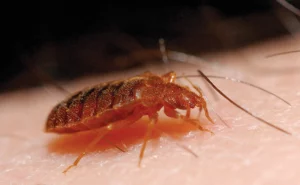
Bed bugs (Cimex lectularius) remain a common indoor pest that is notoriously challenging to manage. The bed bug resurgence of the late 1990s brought this urban pest to the forefront, but continued outbreaks mean bed bugs can persist in the indoor environment. An infestation can be started with a single mated female and, when left unchecked, can grow to number in the thousands.
Given their potential to grow to such high numbers in our homes, recent research has focused on better understanding their potential impacts on human health. The recent identification of histamine — a critical modulator of our immune system — being excreted by bed bugs and introduced into the indoor environment through their feces has spurred further exploration into other possible contaminants from these insects. Indeed, our research, titled “Identification of the pan-allergen tropomyosin from the common bed bug,” examined the link between bed bugs and tropomyosin allergies.
Tropomyosin is a muscle protein found across all animal life, but its status as an allergen is unique in invertebrates. This is because the tropomyosin in vertebrate muscles has a different shape than tropomyosin in the muscles of invertebrates like shrimp, shellfish, house dust mites, cockroaches and termites, to name a few. This different shape often leads to our immune system recognizing invertebrate tropomyosin as an allergen.
To make matters worse, our immune system has trouble telling them apart because of the structural similarities among tropomyosin in shellfish, shrimp and indoor arthropods such as cockroaches and house dust mites. Some people may react similarly to the tropomyosin allergens from different species, regardless of previous exposure (termed “cross-reactivity”).
Given this potential for cross-reactivity, our study sought to examine bed bugs for tropomyosin and identify any potential introduction and exposure pathways of bed bug tropomyosin in the indoor environment.
Studying exposures
No tropomyosin could be detected in bed bug feces in our study. Additionally, no sizable quantities of tropomyosin could be detected from molted exoskeletons (cast skins).
We were, however, able to detect tropomyosin from bed bug bodies when their exoskeletons were crushed or otherwise broken.
Based on that finding, we kept bed bug bodies in storage for a certain period to mimic bed bug cadavers remaining in a home after a typical treatment. Over time, bed bug bodies become brittle and can easily break when disturbed, such as through moving furniture. With that in mind, we mechanically broke the aged bodies to allow tropomyosin to be detected.
In bed bug bodies that were aged for 18 months before being fragmented, tropomyosin still could be detected. This is a pathway through which tropomyosin could quickly become introduced into the environment and breathed in.
Our study used two common bed bug control treatments, heat and silica dust, after which we again evaluated for tropomyosin. Neither treatment appears to affect bed bug tropomyosin detectability. This suggests that while eliminating the risk of bites, these popular pest management strategies do not eliminate the risk of tropomyosin exposure.

Using vacuums
In addition to evaluating tropomyosin entry, we aimed to understand how the pest control industry approaches bed bugs, specifically, their use of vacuums for removal from homes. Therefore, we conducted a survey of bed bug treatment and removal practices with the assistance of industry publications, including Pest Management Professional.
The majority of respondents (81 percent) shared they include vacuuming and removing live bed bugs within their treatment protocols. Only 39 percent include the removal of dead bed bugs after treatment.
Based on our findings, removing live bed bugs likely will reduce the risk of tropomyosin exposure by removing bodies before they become fragmented — and before tropomyosin can be released into the indoor environment. The removal of dead bed bugs following treatment can be used as a supplement to this.
Removing live or freshly dead bed bugs ensures they are less brittle and there is a lower risk of tropomyosin exposure. There are also benefits to physical removal when dealing with pesticide-resistant bed bug populations.
To be on the safe side, we encourage pest management professionals (PMPs) to use vacuums equipped with high-efficiency particulate air (HEPA) filters to prevent any bed bug fragments containing tropomyosin from becoming airborne. Thus, vacuuming can remove a potential allergen source. It also can make distinguishing active and inactive infestations easier by removing bodies, cast skins and other signs of a past infestation.
Minimizing risks
While our study has identified the presence of tropomyosin in bed bugs, the allergenicity of bed bug tropomyosin has not been confirmed in clinical studies. Regardless, the best strategy to minimize potential risk is the removal of bed bugs as part of a management plan.
Additional information on this research study, which was published in Scientific Reports, can be found online. We had an excellent response, and we thank the PMPs who supported our study and provided their insights. We also thank Mark VanderWerp, BCE, of Rose Pest Solutions, for reviewing this article and offering helpful suggestions.
Leave A Comment